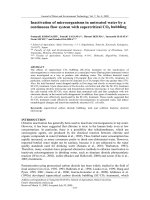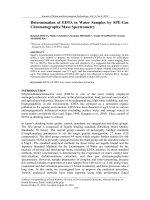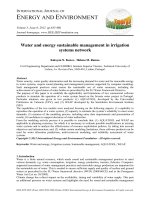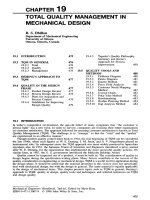Power management in mobile devices by findlay shearer
Bạn đang xem bản rút gọn của tài liệu. Xem và tải ngay bản đầy đủ của tài liệu tại đây (4.14 MB, 337 trang )
Power Management in
Mobile Devices
This page intentionally left blank
Power Management in
Mobile Devices
Findlay Shearer
AMSTERDAM • BOSTON • HEIDELBERG • LONDON
NEW YORK • OXFORD • PARIS • SAN DIEGO
SAN FRANCISCO • SINGAPORE • SYDNEY • TOKYO
Newnes is an imprint of Elsevier
Newnes is an imprint of Elsevier
30 Corporate Drive, Suite 400, Burlington, MA 01803, USA
Linacre House, Jordan Hill, Oxford OX2 8DP, UK
Copyright © 2008, Elsevier Inc. All rights reserved.
See page xviii for registered trademarked products mentioned in this book.
No part of this publication may be reproduced, stored in a retrieval system, or
transmitted in any form or by any means, electronic, mechanical, photocopying,
recording, or otherwise, without the prior written permission of the publisher.
Permissions may be sought directly from Elsevier’s Science & Technology Rights
Department in Oxford, UK: phone: (+44) 1865 843830, fax: (+44) 1865 853333,
E-mail: You may also complete your request online via
the Elsevier homepage (), by selecting “Support & Contact” then
“Copyright and Permission” and then “Obtaining Permissions.”
Recognizing the importance of preserving what has been written,
Elsevier prints its books on acid-free paper whenever possible.
Library of Congress Cataloging-in-Publication Data
Application submitted
British Library Cataloguing-in-Publication Data
A catalogue record for this book is available from the British Library.
ISBN: 978-0-7506-7958-9
For information on all Newnes publications visit our
Web site at
07 08
09
10
10
9
8
7
6
Printed in the United States of America
5
4
3
2
1
To Barbara, Amanda and Andrew
Special thanks to Andrew
This page intentionally left blank
Contents
Preface . ............................................................................................................... xiii
About the Author ................................................................................................... xix
Chapter 1. Introduction to Power Management in Portable
Personal Devices.................................................................................................1
1.1 Power Trends..............................................................................................................4
1.2 Mobile Devices and Applications ..............................................................................6
1.2.1 Cellular Phones ...................................................................................................7
1.2.2 Portable Media Players .....................................................................................15
1.2.3 Portable Digital Audio Players..........................................................................16
1.2.4 Portable Navigation Devices .............................................................................18
1.3 Cellular Handsets: Deeper Dive ...............................................................................20
1.3.1 Cellular System Overview ................................................................................20
1.3.2 Evolution of Cellular Systems ..........................................................................21
1.3.3 Cellular Handset Teardown ...............................................................................25
1.3.4 Seamless Mobility: Connectivity ......................................................................28
1.4 Summary ..................................................................................................................36
Chapter 2. Hierarchical View of Energy Conservation ......................................................39
2.1 Issues and Challenges ..............................................................................................39
2.1.1 Closing the Technology Gaps ..........................................................................39
2.1.2 Always On, Always Connected: Paradox of the
Portable Age .....................................................................................................40
2.1.3 Balancing Battery Life with Performance and Cost ........................................41
2.2 Power versus Energy Types .....................................................................................42
2.2.1 The Elements Power Consumption ..................................................................44
2.2.2 Elements of Dynamic and Static Power ...........................................................44
2.3 Hierarchy of Energy Conservation Techniques .......................................................45
w w w.new nespress.com
viii
Contents
2.4 Low Power Process and Transistor Technology ......................................................50
2.4.1 Process Technology Scaling .............................................................................50
2.4.2 Transistors and Interconnects ...........................................................................54
2.5 Low Power Packaging Techniques ..........................................................................69
2.5.1 Introduction ......................................................................................................69
2.5.2 Systems-in-Package .........................................................................................70
2.5.3 Package-on-Package.........................................................................................70
2.5.4 SiP versus PoP..................................................................................................71
2.6 Summary ..................................................................................................................72
Chapter 3. Low Power Design Techniques, Design Methodology, and Tools ...................77
3.1 Low Power Design Techniques ................................................................................77
3.1.1 Dynamic Process Temperature Compensation .................................................77
3.1.2 Static Process Compensation ...........................................................................79
3.1.3 Power Gating ....................................................................................................79
3.1.4 State-Retention Power Gating ..........................................................................82
3.2 Low Power Architectural and Subsystem Techniques .............................................83
3.2.1 Clock Gating ....................................................................................................83
3.2.2 Asynchronous Techniques: GALS ...................................................................85
3.2.3 Power Saving Modes ........................................................................................88
3.3 Low Power SoC Design Methodology, Tools, and Standards .................................89
3.3.1 Introduction ......................................................................................................89
3.3.2 Low Power Design Process ..............................................................................93
3.3.3 Key EDA Vendors Approach to Low Power Design ........................................97
3.3.4 Low Power Format Standards ........................................................................107
3.4 Summary ................................................................................................................113
Chapter 4. Energy Optimized Software ...........................................................................117
4.1 Mobile Software Platform......................................................................................117
4.1.1 Modem Software ............................................................................................119
4.1.2 Application Software ......................................................................................123
4.1.3 Operating Systems for Mobile Devices .........................................................125
4.1.4 Why an Operating System? Application Execution Environment .................128
4.2 Energy Efficient Software ......................................................................................131
4.2.1 Dynamic Power Management ........................................................................132
4.2.2 Energy Efficient Compilers ............................................................................135
4.2.3 Application-Driven Power Management ........................................................139
www. n e w n e s p re s s .c om
Contents
ix
4.2.4 Advanced Power Management .......................................................................139
4.2.5 Advanced Configuration and Power Interface................................................140
4.2.6 The Demand for Application-Driven Power Management ............................141
4.3 Summary ................................................................................................................145
Chapter 5. Batteries and Displays for Mobile Devices ....................................................149
5.1 Introduction ............................................................................................................149
5.1.1 Battery Challenge ...........................................................................................149
5.1.2 Evolution of Battery Technology ...................................................................152
5.2 Battery Fundamentals ............................................................................................153
5.3 Battery Technologies..............................................................................................155
5.3.1 Sealed Lead Acid............................................................................................155
5.3.2 Nickel Cadmium ............................................................................................155
5.3.3 Nickel Metal Hydride .....................................................................................156
5.3.4 Lithium Ion.....................................................................................................156
5.3.5 Lithium-Ion Polymer ......................................................................................156
5.3.6 Other Lithium-Ion Types ................................................................................156
5.4 Battery Chemistry Selection ..................................................................................157
5.5 Portable Device Display Technologies ..................................................................161
5.5.1 Mobile Device Power Distribution.................................................................162
5.5.2 Backlights .......................................................................................................162
5.5.3 Display Technologies .....................................................................................165
5.6 Low Power LCD Display Techniques....................................................................171
5.6.1 Dynamic Luminance Scaling .........................................................................171
5.6.2 Extended DLS ................................................................................................174
5.6.3 Backlight Autoregulation ...............................................................................175
5.6.4 Frame Buffer Compression ............................................................................176
5.6.5 Dynamic Color Depth ....................................................................................176
5.7 Summary ................................................................................................................177
5.7.1 Batteries..........................................................................................................177
5.7.2 Displays ..........................................................................................................178
Chapter 6. Power Management Integrated Circuits .........................................................181
6.1 Introduction ............................................................................................................181
6.2 Voltage Regulators .................................................................................................183
6.2.1 Control Loop Operation .................................................................................184
6.2.2 Linear Regulators ...........................................................................................185
w w w.new nespress.com
x
Contents
6.2.3 Switching Regulators .....................................................................................188
6.2.4 Linear versus Switched ..................................................................................196
6.3 Battery Management: Fuel Gauages, Charging, Authentication............................200
6.3.1 Fuel Gauges ....................................................................................................202
6.3.2 Battery Charge Management ..........................................................................202
6.3.3 Li-Ion Battery Safety......................................................................................205
6.3.4 Battery Authentication ...................................................................................206
6.3.5 Example of a BMU and Battery Protection ...................................................207
6.4 PMICs Plus Audio..................................................................................................210
6.4.1 Audio ..............................................................................................................212
6.4.2 Linear and Switching Regulators ...................................................................213
6.4.3 Battery Management ......................................................................................213
6.5 Summary ................................................................................................................214
Chapter 7. System-Level Approach to Energy Conservation ..........................................217
7.1 Introduction ............................................................................................................217
7.2 Low Power System Framework .............................................................................218
7.2.1 Advanced Energy Management Solution .......................................................219
7.2.2 Software for Self-Optimizing Systems ..........................................................219
7.3 Low Power System/Software Techniques ..............................................................220
7.3.1 Dynamic Frequency Scaling ..........................................................................221
7.3.2 Dynamic Voltage Scaling ...............................................................................221
7.3.3 Dynamic Process and Temperature Compensation ........................................223
7.3.4 Handling Idle Modes ......................................................................................223
7.4 Software Techniques and Intelligent Algorithms ...................................................224
7.4.1 Operating System ...........................................................................................224
7.4.2 Typical DVFS Algorithm ...............................................................................225
7.4.3 Scope Within Wireless Applications ..............................................................226
7.5 Freescale’s XEC: Technology-Specific Intelligent Algorithms .............................226
7.5.1 XEC Framework.............................................................................................227
7.6 ARM’s Intelligent Energy Manager .......................................................................230
7.6.1 IEM Policies and Operating System Events ..................................................231
7.6.2 Types of policy ...............................................................................................231
7.6.3 Generic IEM Solution ....................................................................................233
7.6.4 Intelligent Energy Controller .........................................................................234
7.6.5 Voltage Islands................................................................................................235
7.7 National Semiconductors: PowerWise® Technology .............................................236
www. n e w n e s p re s s .c om
Contents
xi
7.7.1 PowerWise Technology ................................................................................. 236
7.7.2 Adaptive Power Controller ............................................................................ 236
7.7.3 The PWI Specification .................................................................................. 238
7.7.4 PowerWise PMU/EMU: Power/Energy Management
Unit ................................................................................................................ 240
7.7.5 Dynamic Voltage Scaling .............................................................................. 241
7.7.6 Adaptive Voltage Scaling............................................................................... 242
7.8 Energy Conservation Partnership ...........................................................................244
7.9 Texas Instruments: SmartReflex ............................................................................245
7.9.1 Silicon IP ........................................................................................................246
7.9.2 System-on-Chip..............................................................................................247
7.9.3 System Software.............................................................................................247
7.10 Intel SpeedStep ....................................................................................................248
7.10.1 Usage Modes ................................................................................................248
7.10.2 Power Manager Architecture ........................................................................249
7.10.3 Speedstep DFM ............................................................................................250
7.10.4 Speedstep DVM ...........................................................................................251
7.11 Transmeta LongRun and LongRun2 ....................................................................251
7.11.1 LongRun2 IP ................................................................................................253
7.11.2 Body Bias Controllers ..................................................................................253
7.11.3 Body Bias Voltage Distribution ....................................................................253
7.11.4 Body Bias Voltage Generators......................................................................253
7.11.5 Monitor Circuits ...........................................................................................254
7.12 Mobile Industry Processor Interface: System
Power Management..............................................................................................254
7.12.1 System Power Management .........................................................................254
7.12.2 Power Management System Structure .........................................................255
7.13 Summary ..............................................................................................................257
Chapter 8. Future Trends in Power Management ............................................................261
8.1 Converged Mobile Devices ....................................................................................261
8.2 Future Processes.....................................................................................................263
8.2.1 Nanotechnology and Nanoelectronics............................................................263
8.2.2 Quantum Computing ......................................................................................272
8.2.3 Micro-Electrical and Mechanical Systems.....................................................276
8.2.4 Biological (DNA) ...........................................................................................278
8.3 Future Packaging for Mobile Devices ...................................................................280
w w w.new nespress.com
xii
Contents
8.3.1 System Packaging Evolution ..........................................................................280
8.3.2 Redistributed Chip Packaging ........................................................................281
8.3.3 System-on-Package ........................................................................................284
8.4 Future Sources of Energy for Mobile Devices.......................................................285
8.4.1 Fuel Cells .......................................................................................................287
8.5 Future Displays for Mobile Devices ......................................................................296
8.5.1 Electronic Paper Displays ..............................................................................296
8.6 Summary ................................................................................................................299
Index ................................................................................................................................305
www. n e w n e s p re s s .c om
Preface
Mobile wireless devices with monochrome screens that offer hundreds of hours of
standby time and up to a working day of talk time are primarily voice devices and
are now seen as dated. Consumers demand mobile devices with color screens, faster
processors, and more storage, often with Wireless LAN, Bluetooth, Assisted Global
Positioning System (AGPS), and broadband “always on” wireless connectivity. The
power challenge is even more exacerbated with the advent of high-speed packet access
(HSPA) at 10 Mbps. Applications such as games; AGPS and video conferencing make
mobile wireless devices far more power hungry.
Batteries have evolved through sealed lead acid, nickel cadmium, nickel metal lithium ion,
and lithium-ion polymer. The challenge is that the energy density supplied by the battery
is not keeping up with the demand. Fuel cells offer a solution to the challenge. However,
there are still a few years away from mass commercialization for mobile devices.
The management of energy consumption, for improved battery life, is widely considered
to be the limiting factor in supporting the simultaneous needs of a low cost, high
performance, feature rich mobile device in a small form factor. The current problem is
defined in terms of technology gaps. Given that processor performance (Moore’s law)
doubles every 18 months, communications system performance (Shannon’s Law) doubles
every 8.5 months, and battery energy density only doubles every 10 years highlights a
significant technology gap.
To bridge the supply/demand power gap, engineers and scientists from such diverse
areas as physics, chemistry, mechanical engineering, electrical engineering, biology, and
computer science, have developed an arsenal of technologies ranging from manufacturing
processes, tools, software, hardware, and circuit innovations that combined will deliver
the expected user experience.
w w w.new nespress.com
xiv
Preface
The energy conservation discipline is alive and thriving. Driven by the popularity for
mobile devices and subsequent R&D investments, scientists and engineers are continually
developing creative and innovative solutions required for commercial success of mobile
products. However, without a “crystal ball” only time will tell which solutions will
ultimately succeed in solving the problem of efficient energy utilization.
Scope and Outline of the Book
The book provides an in-depth coverage of the technical challenges the mobile device
industry has to embrace and resolve to meet the ever growing consumer demands for
nomadicity and the insatiable demand for smaller form factor, lower cost, feature rich
mobile devices with longer battery lives.
A pictorial representation of the contents of the book is shown in page xv.
Chapter 1, “Introduction to Power Management in Portable Personal Devices” discusses
the growing trend for mobile devices, including smartphones, portable media players,
game machines, and portable navigation devices. In addition, a deep dive of the most
ubiquitous mobile device, the cellular phone, is presented. This includes cellular
technology operation and evolution and how it is paired with Bluetooth and Wi-Fi to
provide seamless mobility.
Chapter 2, “Hierarchical View of Energy Conservation”, is concerned with the
“technology gaps” that have widened over time due to the different rates that various
components, that comprise a mobile device, have evolved. These gaps include the
microprocessor and memory bandwidth gap; power reduction gap; and algorithmic
complexity gap. A top-down holistic approach is required to address the technology
gaps. Manufacturing processes, transistors, and packaging elements, of the holistic
solution to the technology gaps, are presented in the chapter. Multi-gate transistors,
copper interconnects and low-k dielectrics are some of the key technologies described.
In addition, the benefits of packaging techniques, such as System-in-a-Package (SiP) and
Package-on-Package (PoP), are presented.
Chapter 3, “Low Power Design Techniques, Design Methodology, and Tools”, focuses
on the role played by low power design techniques, such as dynamic process temperature
compensation, static process compensation, power gating, state retention power gating,
and clock gating and asynchronous techniques, for energy conservation. Low power
System-on-a-Chip (SoC) design methodologies, tools and standards are also addressed. In
the standards section, the Common Power Format and Unified Power Format are reviewed.
www. n e w n e s p re s s .c om
Preface
Nanoelectronics
xv
Power Trends
Quantum
Mobile Devices
and Applications
MEMS
System-on-Package
Cellular Handset
Deep Dive
ePaper
MIPI SPM
DVFS
Systems
Freescale XEC
Approach
NSC PowerWise
Introduction
Future Trends
Fuel cells
Seemless Mobility
Technology Gaps
Hierarchical
View of
Energy
Conservation
Processs and
Transistors
Power
Management
in Mobile
Devices
ARM IEM
Dynamic and Static
Power Consumption
Packaging
Voltage Regulators
Sip
Pop
Power Gating
Power
Battery Management
Battery Technologies
Display Technologies
Dynamic Luminance
Scaling
Design
Techniques
Energy optimized
software
Battery evolution
Low Power
Management
ICs
Batteries
Displays
PMIC ϩ Audio
State Rentention
Power Gating
Clock Gating
SoC Design
Standards
CPF
UPF
Modem
Application
Operating System
Dynamic Power
Management
Application Power
Management
Chapter 4, “Energy Optimized Software”, covers the software platforms and components
that constitute a mobile device. Software mobile platforms, including Microsoft Windows
Mobile, Symbian, Linux or RTOSs, as well as middleware runtime Java and Brew, are
addressed. In addition, the chapter addresses the numerous software techniques employed
to conserve energy. These techniques include dynamic power management, energy
efficient compilers, and application-driven power management. The chapter concludes by
highlighting the growing importance of software in today’s mobile device.
w w w.new nespress.com
xvi
Preface
Chapter 5, “Batteries and Displays for Mobile Devices” addresses two of the most
important components today in a mobile device, the battery and the display. Battery
evolution, from sealed lead acid to lithium-ion polymer, is reviewed. Also battery
fundamentals and chemistry selection are addressed in depth. In addition, portable device
display technologies, and their significant impact on energy consumption in a mobile
device, are addressed. Display technology approaches, like emissive, transflective,
reflective, and transmissive, are described. Key energy conserving LCD techniques,
including dynamic luminance scaling and backlight auto regulation, are also covered in
this chapter.
Chapter 6, “Power Management Integrated Circuits” focuses on how power management
needs have proliferated exponentially with the variety of mobile devices, features and
functions growing enormously in the recent years. As long as the mobile phone was simply
required to make and receive phone calls, it embodied one set of power management
requirements. However, as mobile phone manufacturers have heaped on the features, each
requirement placed another demand on power management. Major power management
components, such as linear (low dropout, LDO) and switching regulators (buck, boost),
are covered in depth. Also battery management functions, such as fuel gauges, charging,
authentication, and protection, are also considered in Chapter 6. The chapter concludes by
describing next generation PMICs that go beyond simple signal conditioning and distribution
of power. By integrating a wide range of functions tailored to specific applications, such
as full-featured audio paths with analog, digital, and power audio interfaces, touch screen
support, coin cell backup supply switching and charging, backlighting, LED drivers, and
regulators optimized for specific functions such as cellular radios.
Chapter 7, “System Level Approach to Energy Conservation”, addresses the need for an
entire system approach to energy conservation. With a highly integrated systems approach,
an important element, the Power Management IC, enables developers to optimize power
consumption at the system level, while significantly reducing the design complexity
required to achieve these gains. Companies such as AMD, Intel, Texas Instruments,
Freescale Semiconductor, ARM, National Semiconductor, and Transmeta have obtained
good results using different levels of a system approach to energy conservation. In addition
to the proprietary commercial approaches, the Mobile Industry Processor Interface (MIPI)
System Power Management (SPM) Architectural Framework is described.
Chapter 8, “Future Trends in Power Management”, starts by presenting the ever
demanding future requirements of mobile devices. Cellular download data rates of
100 Mbps and high definition video are some examples of power hungry technologies.
www. n e w n e s p re s s .c om
Preface
xvii
One conclusion reached in this chapter is the paramount role manufacturing processes
will play in the future of energy conservation. From thin body to Fin-FETs, heterogeneous
materials including high-k metal gates, Micro-Electrical and Mechanical Systems
(MEMS), nanoelectronics, quantum computing, and genetic engineering will all
contribute to achieve the goal of energy conservation. In addition, packaging technologies,
like Freescale’s Redistributed Chip Packaging and System-on-a-Package, will play a
key role on the path to efficient energy utilization. Finally, the importance of fuel cell
technology and ePaper displays in energy conservation, are highlighted in Chapter 8.
Target Audience
The target audience may be a diverse group covering all aspects of technology and
product development from the mobile device industry and academia. This audience
includes, but is not limited to technical managers, software developers, and hardware
designers, manufacturing engineers, technical marketers, strategists, analysts, and
business managers. The book should also appeal to students taking senior or graduate
level mobile computing courses and those with an interest in working in the mobile
device industry and its related value chain.
w w w.new nespress.com
iPhone and iPod are registered trademarks of Apple Inc. Bluetooth is a registered trademark of
Bluetooth SIG, Inc. Iriver Clix is a registered trademark of Reigncom Ltd. Motorola, Dynatac are
registered trademarks of Motorola Inc. FLO is a registered trademark of Qualcomm Inc. Gameboy
is a registered trademark of Nintendo of America Inc. Sun, Java, J2ME, J2SE, J2EE are registered
trademarks of Sun Microsystems Inc. Nokia, N95, S60 are registered trademarks of Nokia
Corporation. Sansa is a registered trademark of SanDisk Corporation. Microsoft, Windows Mobile
are registered trademarks of Microsoft Corporation. Cadence, VoltageStorm, Verilog, Incisive,
Encounter are registered trademarks of Cadence Design Systems Inc. Synopsis, VCS, Design
Compiler Ultra, TetraMAX, PrimeTime, VHDL, JupiterXT, HSIMplus are registered trademarks of
Synopsis Inc. ARM is a registered trademark of ARM Limited. SystemC is a registered trademark
of Open SystemC Initiative. Wi-Fi is a trademark of the Wireless Ethernet Compatibility Alliance.
Linux is a registered trademark of Linus Torvalds in the United States and other countries. Sony,
PSP and Memory Stick is a registered trademark of Sony Corporation. AMD is a registered
trademark of Advanced Micro Devices Inc. Fujitsu is a registered trademark of Fujitsu Limited.
National Semiconductor, PowerWise, PWI are registered trademarks of National Semiconductors
Inc. Qualcomm, BREW are registered trademarks of Qualcomm Inc. Symbian, UIQ are registered
trademarks of Symbian Software Ltd. Research In Motion is a registered trademark of Research
In Motion Ltd. Intel, Intel SpeedStep are registered trademarks of Intel Corporation. Toshiba is a
registered trademark of Toshiba Corporation. Palm is a registered trademark of Palm Inc. DoCoMo
is a registered trademark of DoCoMo Japan. Compaq is a registered trademark of Compaq
Computer Corporation. Realplayer is a registered trademark of Progressive Networks Inc. Applied
Materials is a registered trademark of Applied Materials Inc. IEEE is a registered trademark of
Institute of Electrical and Electronic Engineers, Inc. Calypto is a registered trademark of Calypto
Design Systems, Inc. Freescale is a registered trademark of Freescale Semiconductor, Inc.
Transmeta, Crusoe, Code Morphing, LongRun, Efficeon are registered trademarks of Transmeta
Corporation. MIPI is a registered trademark of the MIPI Alliance, Inc. RadioShack is a registered
trademark of TRS Quality, Inc. Toshiba is a registered trademark of Toshiba Corporation. flickr is a
registered trademark of Yahoo, Inc.
The names of actual companies and products mentioned herein may be the trademarks of their
respective owners.
www.n e w n e s p re ss .c o m
About the Author
The author, Findlay Shearer, holds a B.S.E.E. from Glasgow Caledonian University and
a M.S.S.E. and M.B.A. from University of Texas at Austin. He is currently a Senior
Product Manager in Freescale Semiconductor, Inc.
w w w.new nespress.com
This page intentionally left blank
CHAPTE R 1
Introduction to Power Management in
Portable Personal Devices
The number of personal portable devices sold each year is increasing rapidly. Cell phones
are ubiquitous. Worldwide sales for 2007 are shown in Figure 1.1[1]. The mobile phone
industry is currently the largest consumer electronics (CE) segment in the world. The cell
phone has replaced the personal computer as the most universal piece of technology in
our lives. Industry analysts indicate that cellular phones are outpacing personal computers
at the rate of 5 to 1.
Mobile subscriptions worldwide
30 June 2007
Market share at 30 June 2007
GSA
GSM incl. WCDMA-HSPA
85.4%
CDMA
12.1%
GSA
www.gs.acom.com
GSM including
WCDMA-HSPA
2.54 billion total
564 million annual growth
CDMA
360 million total
51 million annual growth
Others
75 million total
42 million annual loss
Others ϭ AMPS, IDEN, MWT, PDC, TDMA
Others: 2.5%
Source of data
informa
telecoms & media
Figure 1.1: Mobile Subscription for Cellular Handsets
Personal mobile devices are increasingly becoming more than just devices for voice
communication as they have a multitude of features including connectivity, enterprise,
and multimedia capabilities.
w w w.new nespress.com
2
Chapter 1
Another growing application area for personal portable devices is entertainment.
Devices like portable media players (PMP), FM radios, MP3 players, and portable
gaming devices are found in every electronics store. Portable music has improved
significantly since the days of the cassette tape; a collection with 500 h of music now
fit inside a shirt pocket.
In addition, gaming devices provide portable entertainment. Portable gaming devices
were pioneered by Nintendo with the Gameboy. The gaming devices evolved from simple
toys into powerful computers with the progress of technology. These gaming devices turn
kids into young consumers that think digitally and prepare them for the mobile device
market. Figure 1.2 shows the Sony Play Station Portable which is capable of playing
games, music, video, and has a Wi-Fi connection.
Figure 1.2: Portable Game Machine Sony PSP
Source:
Information access, manipulation, and processing are also significant markets for portable
devices. Instead of using a paper calendar, people are turning to a mobile device to
organizing their lives.
Analog cameras have been replaced with digital counterparts. Laptop computers are
dropping in price and have become affordable for a large audience. In business, the laptop
computer is common. Laptops with wireless connections to the Internet either via Wi-Fi
or cellular networks are now appearing, enabling full user mobility and broadband speed
equivalent to their wired competitors like cable or DSL. Access to the Internet from a
laptop offers the user a rich set of services. However, information access from portable
devices is still underdeveloped.
A significant trend in portable devices is to reduce size. For several functions, devices
have been shrunk toward their ultimate size: the size of an ordinary wrist watch. An even
smaller size would further compromise usability. Wrist watch models exist on the market
for cellular, global positioning system (GPS) location, photo camera, and MP3 audio
www. n e w n e s p re s s .c om
Introduction to Power Management in Portable Personal Devices
3
applications. An increasing number of devices become more versatile, programmable,
and flexible. For example, many mobile phones can also play music, take pictures, and
have location-based capabilities.
This versatility also stimulates the shift toward multi-modality. Multi-modality means
that the user interface supports multiple methods of interaction with the device, such
as touch screens, speech, motion, or even gestures for portable devices equipped with a
camera. Portable devices for information are no longer limited to plain text and devices
for communication provide more than mere voice services.
The future of portable devices is difficult to forecast. The future personal portable devices
are more than just devices for voice communication. Sure they have voice capabilities;
however, it can replace a laptop with 100 Mbps data rate, e-mail, Internet browsing, and
e-commerce. In addition it has a full range of multimedia capabilities including 8Mpix
camera, camcorder, HD video, TV capability, and security capability to protect highvalue content like movies and software.
Within this future scenario, the dominant type of device will be the generic multipurpose device, similar to the device in Figure 1.3, that can be used for a wide range of
applications.
Figure 1.3: Converged Mobile Phone, i-mate JASJAR
Source:
w w w.new nespress.com
4
Chapter 1
However, there are severe problems with mobile devices. The cell phone has a limited
talk time and may die in the middle of a conversation. The mobile MP3 music player
can store a collection of 500 h, but the batteries last less than 24 h. The portable gaming
device has a display that is very difficult to read. A laptop only works for a few hours;
after that it just becomes an unusable brick. The GPS locator that’s on your wrist can only
measure your position continuously for 4 h on one battery. The above examples illustrate
that battery lifetime is a shared problem for portable devices.
The fundamental components of a wireless multimedia device are shown in Figure 1.4.
The wireless multimedia devices that have been created are still not up to the task. More
research and development is needed. Common problems with such devices are their
insufficient performance, large size, high price, and limited battery lifetime.
Display
Radio
Processor
Memory
Video decoder
Flash
Audio decoder
Hard disk drive
Power
management
battery
Figure 1.4: Wireless Multimedia Device
1.1 Power Trends
Power consumption is the limiting factor for the functionality offered by portable devices
that operate on batteries [2]. This power consumption problem is caused by a number
of factors. Users are demanding more functionality, more processing, longer battery
lifetimes, and smaller form factor and with reduced costs.
Battery technology is only progressing slowly; the performance improves just a few
percent each year. Mobile devices are also getting smaller and smaller, implying that the
amount of space for batteries is also decreasing. Decreasing the size of a mobile device
results in smaller batteries, and a need for less power consumption. Users do not accept a
battery lifetime of less than 1 day; for personal portable devices even lifetimes of several
months are expected.
www. n e w n e s p re s s .c om









